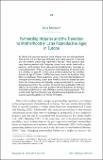Files in this item
Partnership histories and the transition to motherhood in later reproductive ages in Europe
Item metadata
| dc.contributor.author | Mikolai, Julia | |
| dc.date.accessioned | 2020-06-01T23:36:12Z | |
| dc.date.available | 2020-06-01T23:36:12Z | |
| dc.date.issued | 2017-06-02 | |
| dc.identifier | 249039074 | |
| dc.identifier | 654fea65-5579-49f5-8f73-3c1e8716d9ad | |
| dc.identifier | 000402782500005 | |
| dc.identifier.citation | Mikolai , J 2017 , ' Partnership histories and the transition to motherhood in later reproductive ages in Europe ' , Population: English Edition , vol. 72 , no. 1 , pp. 123-154 . https://doi.org/10.3917/popu.1701.0127 | en |
| dc.identifier.issn | 1634-2941 | |
| dc.identifier.other | ORCID: /0000-0002-7733-6659/work/48516893 | |
| dc.identifier.uri | https://hdl.handle.net/10023/20027 | |
| dc.description | Júlia Mikolai was a PhD student at the Department of Social Statistics and Demography at the University of Southampton and was funded by a scholarship provided by the Economic and Social Research Council (ES/J500161/1) while completing most of this work. | en |
| dc.description.abstract | Changing partnership experiences might accentuate fertility postponement and lead to increased uncertainty as to whether women will remain childless unwillingly. Previous research typically focused on current partnership status and a single country when studying the link between partnerships and first birth. We examine how current partnership status and partnership histories of women who remained childless by age 30 or 35 are linked to later transition to motherhood in twelve European countries. Women born between 1953 and 1962 are analysed using data from the Harmonized Histories. In Western and Northern European countries, women who married their cohabiting partner by age 30 have the highest probability of achieving a first birth between age 30 and 40, followed by the directly married. We find the opposite in Southern European and post-socialist countries. Cohabiting women generally have smaller first birth probabilities than directly married women. In Western and Northern Europe, never partnered women are the least likely to have a child by age 40 whereas in the remaining countries, women who are single following union dissolution have the smallest first birth probabilities. This study highlights that women’s opportunities to become a mother at later ages are linked to their partnership histories in different ways across Europe. | |
| dc.format.extent | 385378 | |
| dc.language.iso | eng | |
| dc.relation.ispartof | Population: English Edition | en |
| dc.subject | First birth | en |
| dc.subject | Partnership histories | en |
| dc.subject | Current partnership status | en |
| dc.subject | Childlessness | en |
| dc.subject | Europe | en |
| dc.subject | G Geography (General) | en |
| dc.subject | D901 Europe (General) | en |
| dc.subject | HA Statistics | en |
| dc.subject | 3rd-DAS | en |
| dc.subject.lcc | G1 | en |
| dc.subject.lcc | D901 | en |
| dc.subject.lcc | HA | en |
| dc.title | Partnership histories and the transition to motherhood in later reproductive ages in Europe | en |
| dc.type | Journal article | en |
| dc.contributor.institution | University of St Andrews. Geography & Sustainable Development | en |
| dc.identifier.doi | https://doi.org/10.3917/popu.1701.0127 | |
| dc.description.status | Peer reviewed | en |
| dc.date.embargoedUntil | 2020-06-02 | |
| dc.identifier.url | http://www.journal-population.com/list-of-issues/ | en |
This item appears in the following Collection(s)
Items in the St Andrews Research Repository are protected by copyright, with all rights reserved, unless otherwise indicated.

